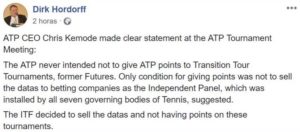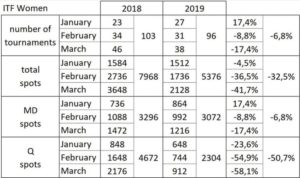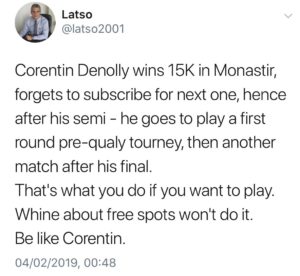In this blog I will aim to fill in some of the blanks in terms of how the new changes are currently affecting players (and coaches). I’ll share opinions from some of the first ITF Transition Tour events of the year in Monastir, Tunisia where I spent the last 2 weeks, as well as the many different articles, comments and blogs posted on social media. Lastly, I want to address the mentality needed to find solutions to this moving forward.
For those who aren’t yet familiar, here are the basic changes from 2018 to this year:
- A player can now have 2 rankings:-
- ITF Transitional Tour ranking
- ATP/WTA Ranking
- At the lowest level events – the old 15K events which I am at this week in Tunisia – the only points on offer are Transitional Tour points. If you make last round Qs you receive 2 transition points all the way to 30 for semis, 60 for the final and 100 for the win.
- Any points you collected from 15K events last year will translate to your ITF Transition Tour ranking this year and be ‘lost’ from your ATP/WTA ranking – this is where some of the frustration comes from. An example is SotoTennis player Evan Hoyt who was 410 ATP at the end of the year pushing for Challenger Main Draws and overnight he dropped to 495 ATP – more on that later. For more information on how the points work follow the links below.
The frustration is completely understandable and the reality of most ‘suspect’ situations is normally money related. Tweets like this from the Vice-President of the German Tennis Federation, Dirk Hordorff only add fuel to that fire: 
4. Girls 25K and above you start to collect WTA points as per last year’s system. There are no ITF transition tour points on offer.
5. Boys 25K and 25K + H you earn Transition Tour points in these events, but ATP points if you make the final or win in 25K and make semis of 25K + H or better. The points earned from 25Ks last year for the same results count towards your ATP Ranking.
6. How do you get into events?
-
- ITF Transition Tour M/W15 – firstly on your ATP/WTA ranking, then on your ITF World Ranking. There are 5 spots available for top 100 Juniors in the world
-
- Only 24 spaces into Qualifying with 4 being WCs, so only 20 spaces for those players with rankings – here lies our next big issue. There just isn’t enough places and a massive cut of places from last year, so those with a half decent ranking from last year are not getting into the events. Only a couple of weeks ago one of our STA players in Tunisia missed out on qualifying by 2 spots – the week before she got into qualifying. Frustrating right? These tables show the changes in opportunities to get into the events from 2018 to 2019:


-
- M/W25K – Based on your ATP/WTA Rankings with 5 places reserved in Main Draw for those with the highest ITF World Ranking
-
- 60K and above Women – spaces are completely given on WTA ranking.
-
- ATP Challengers – 4 spaces in MD and 3 spaces in Qs reserved for those with the highest ITF World Ranking. There were some smart players who got their ITF World Ranking up at the end of last year and they are currently playing all the ATP Challengers. This is forcing players’ hands to go ‘chase’ ITF points, as if a player is top 30 ITF World Ranking they are getting into most ATP Challengers. This is counter productive to why the tour was set out in my opinion.
The Challenge Ahead
This leads me to the main issues we are finding which are in tune with the current toxic feeling many have on tour:
- Less opportunities for people to ‘start’ playing if they are ranked outside of the top 100 Junior, coming back from injury or coming out of college.
- Players seeing their rankings drop overnight and in turn not being able to get into the level of events they could in 2018.
- Players having to play two Qualifying matches per day at all ITF levels – not the respect the players, or the physicality of the current game deserve.
- To put the nail in the coffin, an entry fee has been introduced for Main Draw ITF Transition Tour events – this is not the major concern, but when minds are fraying this is one more ‘annoyance’ to get your mind stuck on.
- Lastly, there are less tournaments and the event options on the Transition Tour seem to be mainly the ‘resort’ venues which can be stressful places to be, and even more now that the tournament directors are seeing
-
- Less players taking up beds due to low Qualifying numbers
-
- Players are now staying ‘off site’ to save on their expenses which leads to less beds been taken at the official hotel and in turn the business model falls down.
The bottom line is the ITF have so far failed to deliver on their promises (see pic below taken from the ITF website) and I am in agreement that players and coaches have the right to fight for this. Write letters, sign petitions and make the ITF aware of the situation and let’s see if they can be moved into re-thinking the structure of the events. 
Facing Up to Adversity
At this point I am going to change the mood and the direction in how I am looking at this. As a Director of an Academy with many coaches, players and parents looking for me to lead the way, I have learned to say the word ‘good’ in difficult situations. I am a big believer that there is always opportunity in adversity if we are open minded enough to find it. So my message is clear to all coaches, players and parents: let’s start looking for solutions and opportunities that can come from these changes. 10% of life is what happens to us and 90% is how we respond. Is the situation perfect? Of course not, but the players who respond best to these changes and channel their energies in the right direction are the ones who will reap the benefits. I’ll be fighting tooth and nail to ensure all of our players are thinking in a positive manner on this. I understand this can sound fluffy without some action plans, so here are a few solutions I see in the short term. Additionally, with a positive mind-set, I have no doubt many more opportunities will uncover themselves and those players who ‘want’ it badly enough and are good enough will still shine through.
- For those whose rankings have dropped, there is opportunity to play more matches at ITF level and hone your skills, identity and take a little longer before moving up to the next level of tennis whether the 25/60K in the Women’s game or ATP Challenger in the Men’s. I am very proud of how Evan Hoyt has responded to the changes this week in Tunisia where with the right attitude his level has got better, and he has edged closer to the next level in terms of ranking as a result of this. He could have easily sulked and complained and if he had done, he would have fallen short against high quality opponents from round one. It may take him slightly longer to achieve his goals, but ultimately we know if he is good enough he will get there.
- For those not getting into the events:
-
- Spend some time playing money tournaments. There are plenty if you search for them and in doing so build up your bank balance for when the tournaments become more accommodating and build up your confidence winning matches and developing your clear game identity.
-
- Spend time working on your game/physicality – a little extra training block never hurt anyone.
These are all things in your control. The definition of mental strength for me is the ability to take responsibility of your own actions in any situation, with acceptance for those things out of your control. Stay proactive.
Challenging the Norm
The other thing I already see happening is Tournament Directors taking some control:
- Last week in Tunisia there was a Pre Qualifying event for the Men.
- In Portugal in a couple of weeks we spoke to the TD and he has now put on a WC event and guaranteed a WC into Qs and Main Draw from that.
My proposed solution to the ITF is relatively simple: Expand the Qualifying draws in Transition Tour events to 48/64 and in ATP Challenger events to 16. And/or Create a clearer pathway for players to gain opportunities to play in the Transition Tour events. One thought is that this is linked to your UTR (Universal Tennis Rating) and there are a high number of localised events to help players compete and in turn gain an accurate UTR to ‘earn’ the right to compete at Transition Tour Level. The players who deserve to compete at ‘pro level’ will soon find their level and those that don’t have the level, well this is how it should be, as previously anybody could say they were a ‘pro tennis player’ just by virtue of ‘places being available’. This will provide more opportunities for players to compete and will also provide more ‘incentive’ to tournament directors to continue running the events that are needed for players to get started in the game. Ultimately, the ITF have to find a way to create a pathway into the Transition Tour events whilst keeping the perception of achievement for getting into the events. If they can do this successfully, I see this as a positive from the ‘old’ system. There is going to be a certain amount of let’s wait and see how it develops. No one likes change and admittedly the changes haven’t filled everyone with confidence in the first few weeks of the year. However, we can find opportunities to compete and develop and no one can take away your positive mind-set if you take that responsibility to do so.
How do you want to respond?
I pose the question to you all – where is your opportunity in this adversity? In Tunisia I witnessed this first hand and the attitude Corentin Denolly has shown is the positive example I would like to leave you all with:

I know I see big opportunity for SotoTennis Academy despite being told how much these rules will affect small tennis academies. We are perfectly set up and have a track record in producing and providing the right environment for players to make top 100 Junior in the world, which is the clear message that the ITF are sending in terms of benchmark. For those who fall short of that for one reason or another, we are also perfectly set up to ensure players have a strong combination of tennis and academics in the ACES (Academic Centres for Excellence in Sport) Programme to keep the options open of US College or UK University scholarships aged 18. Lastly, for those who do want to play on the Pro Tour before or after College we have our team set up for this, so for us, it’s business as usual.
Control the Controllables
Dan Kiernan, SotoTennis Academy Director
Click here for more information about our Full Time and Access Programmes.
The ITF, ATP, and WTA are going to implement a new set of rules to prevent highly ranked players from competing on the transition tour. This will maximize opportunities for up-and-coming players. It is expected that most players with either an ATP or WTA ranking would choose to enter professional tournaments under this new structure.